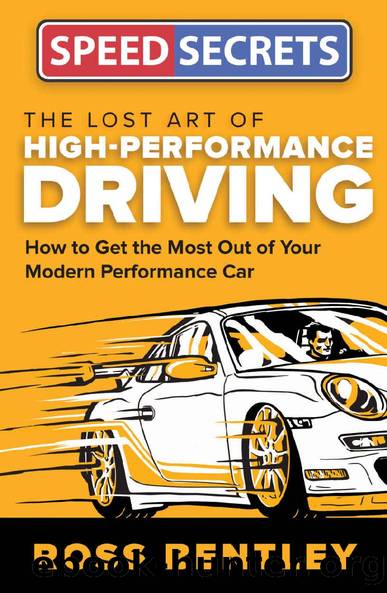The Lost Art of High-Performance Driving (Speed Secrets) by Ross Bentley

Author:Ross Bentley [Bentley, Ross]
Language: eng
Format: epub
Publisher: Motorbooks
Published: 2017-07-01T07:00:00+00:00
SPEED SECRET
Control understeer and oversteer with your vision and managing weight transfer.
1. Ease your foot off the throttle to transfer weight onto the front tires, giving them more traction.
2. Slightly straighten the steering wheel, just enough so that the front tires regain grip on the road/track surface.
Letâs now take a look at oversteer: remember that your rear tires have less traction than the fronts have in this situation.
Imagine going around a corner, and the back end of your car slides out. Youâre oversteering. What do you do? Give those rear tires more traction. Now. Itâs a challenge, because there are two opposite ways of doing this, and the right one is dependent on what caused the oversteer. Yes, there are actually two kinds of oversteer: oversteer and power oversteer.
The first kind of oversteer is simply when the rear tires have less traction than the fronts. This is most often caused by the weight balance or handling characteristics of the car, but speed is also a big factor.
Power oversteer is driver induced: itâs caused by the driver applying too much throttle and generating wheelspin, which breaks the traction of the rear tires and causes the car to slideâto oversteer. If youâve ever played around in a snow-covered parking lot, pouncing on the gas pedal and kicking the rear of the car out into an oversteer skid or slide, you know what Iâm talking about. Oh, and, power oversteer can only occur in a rear-wheel-drive car (or all-wheel drive that is biased towards rear drive).
With power oversteer, simply ease a little off the throttle to give the rear tires back some of their grip. If itâs regular oversteer, squeeze on the throttle to cause some weight transfer to the rear, giving the rear tires more grip.
I wish it was simple, with only one solution to handle every case of oversteer, but itâs not. You have to decide, in a fraction of a second, whether the oversteer is caused by too much or not enough throttle. Thatâs why practice time on a skid pad is so valuable.
When you ease on more throttle to transfer weight to the rear, remember that speed is one factor that caused the oversteer. In this situation, you donât need more speed, so when I say ease on more throttle, I mean âease,â and not âstand on the throttleâ! Be smooth and gentle.
Thereâs one other thing that you must do in whatever oversteer situation you face: look and steer where you want to go.
Iâm sure you were told when you first learned to drive to always âsteer into the skid.â Thatâs valuable advice, but itâs confusing, and maybe one of the most confusing things weâre ever taught in our lives.
If youâre going around a right-hand corner and your car begins to oversteerâsay, the rear slides out to the (left) sideâwhich way should you turn the steering wheel? âInto the skidâ sounds easy, but for many people itâs not a natural choice: which direction is that? If youâre oversteering in
Download
This site does not store any files on its server. We only index and link to content provided by other sites. Please contact the content providers to delete copyright contents if any and email us, we'll remove relevant links or contents immediately.
| Buyers' Guides | Classic Cars |
| Customize | Driver's Education |
| Electric & Hybrid | Foreign |
| History | Industry |
| Insurance | Luxury |
| Motorcycles | Pictorial |
| Racing | Repair & Maintenance |
| Trucks & Vans |
Urban Outlaw by Magnus Walker(2953)
Never by Ken Follett(2911)
OPNsense Beginner to Professional by Julio Cesar Bueno de Camargo(2831)
Sapiens and Homo Deus by Yuval Noah Harari(2423)
Machine Learning at Scale with H2O by Gregory Keys | David Whiting(2321)
A Short History of Nearly Everything by Bryson Bill(2140)
Will by Will Smith(2066)
Hooked: A Dark, Contemporary Romance (Never After Series) by Emily McIntire(2003)
Borders by unknow(1792)
Rationality by Steven Pinker(1775)
Holy Bible (NIV) by Zondervan(1718)
Freedom by Sonny Barger(1489)
The One Percenter Encyclopedia by Bill Hayes(1470)
Five Ways to Fall by K.A. Tucker(1405)
Girls Auto Clinic Glove Box Guide by Patrice Banks(1369)
Far and Near by Neil Peart(1360)
The Becoming by Nora Roberts(1342)
Cuba's Car Culture by Tom Cotter(1329)
A Short History of War by Jeremy Black(1307)
